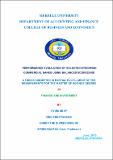| dc.description.abstract | The financial measures were sufficient enough to indicate the performance of the machine like nature of the corporate entities during the industrial age. This was because the competition during this age was ruled by scope and economies of scale i.e. management of intangibles assets to create long term capabilities and customer relationship were not critical to succeed. These measures have been also considered as effective and objective measures to evaluate the effectiveness and efficiency of business operations or divisions in utilization both financial and physical assets of the business organizations.
Despite their apparent effectiveness and objectivity, financial indicators are frought with a number of limitations which exposed them to increasing critics by a number of researchers and authors by 1990s (Neely et al., 1995; Marr and Schiuma, 2002). Kaplan and Norton (1996) for instance, argue that in order to compete and survive in the information age, in which information forms fundamental part within the trade and industry, it is not longer enough to relay solely on financial measures because they could conduce to an incorrect picture of the effectiveness and profitability of a business.
Acknowledgement of these limitations has led the theorists as well as practitioners to recommend strongly a move from the traditional accounting in to a form of control where the business results are measured in several perspectives.
Furthermore, recent literature studies related to commercial banks performance measurement point to the increasing relevance of financial as well as non financial measures in the evaluation of commercial banks. These all clearly show that the need for the balanced performance measurement such as balanced scorecard, which appears to have all the answers for choosing the most appropriate measures of company performance, to assess the performance and competitiveness of organizations in general and commercial banks in particular in today‟s and tomorrow‟s changing and competitive business environment.
Almost all of the commercial banks in Ethiopia, however, solely depend on purely financial indicators to measure their performance and competitiveness in the banking industry. Even national bank of Ethiopia, which is the ruling body, uses financial metrics to assess performance and competitiveness of the commercial banks in the country.
v
All these attempts to measure performance and competitiveness of banks do not take into account the effect of the leading, forward-looking, and critical performance measures( non-financial perspectives) and therefore creates a huge vacuum in the performance and competitiveness evaluation of banks in the country , which this study seeks to fill in by providing information on performance of banks in Ethiopia via applying balanced scorecard model which balances financial and non-financial perspectives very well.
This study, therefore, aimed at assessing performance of the selected Ethiopian commercial banks using balanced scorecard as frame work. The study used both quantitative and qualitative research methods to gather data from primary sources (structured questionnaires) and secondary sources (annual reports). The researcher used quota and convince sampling methods to select customers, employees and managers as respondents. Finally the researcher used structured questionnaires and unstructured interviews as survey instruments and data analysis tools such as descriptive statistics, correlation and regression analysis with the help of SPSS for Windows Version 17.0.
In conclusion therefore, the balanced scorecard framework can be implemented to assess performance of commercial banks in Ethiopia. The BSC framework can also assist by providing additional information using measures in several dimensions such as customer perspective, internal business processes perspective and learning and growth perspective to managers, shareholders and other interested stakeholders regarding the performance of the commercial banks in Ethiopia. This will enable commercial banks focus on the core strategies in order to create and deliver superior value and returns to their stakeholders. This puts the shareholders in an informed position regarding the value the banks are delivering to them in the short-run versus the long-run. From the data gathered and the analysis done so far, additional information on customer dissatisfaction on internal processing functions of the selected commercial banks, poor customer service and inefficient internal processes coupled with low employee motivation indicate that these commercial banks need to do a lot to satisfy their customers and motivate their employees. This information can be very useful to both shareholders and management of the banks which can help them fine tune the execution of their strategies. The result of the analysis revealed that there is a clear and strong relation between the financial performance and the non-financial performance measures (customer satisfaction, internal process/operational and employee satisfaction). In addition, empirical findings suggested that the non-financial measures are significant explanatory factors of financial
vi
performance. More importantly, the findings of the study proved the cause-and-effect relationship between the financial and non-financial performance in these commercial banks.
Based on the results of the study important policy recommendations are outlined.Ethiopian commercial banks should implement the balanced scorecard and multi-dimensional measures as a performance measurement and strategic implementation tool to improve their operational performance and profitability. National Bank of Ethiopia should include other non-financial perspectives as elaborated in this paper in its annual or quarterly report on the performance of banks so that the investors, academics and the general public are better informed on the holistic performance of banks in Ethiopia. Lessons about the role and importance of the multi-dimensional performance measures for banks should be given for finance and banking students in reasonable depth.
There is the need to place emphasis on the fact that, when implementing this framework, banks must follow a well planned methodology and the advice that was given in different academicians and practitioners in order for them to reap the full benefit of their investment. | en_GB |


